Rabbits are troublesome! The fast fluffy-tailed herbivores love munching on nearly everything on the soil. They are rude enough to dig holes and make nests in your yard full of tulips. They are heavenly cute, but a nuisance!
The creatures that many people find fluffy and soft and an Easter darling for most homesteads are annoying and destructive and cause costly damage for most farmers. Cursing and keeping watch doesn’t even do much but wears you out.
Surprisingly, the cute little monsters are easy to deal with. And though you may be profoundly mad at them, there is no reason actually to harm the rabbits.
Even though they are annoying, most growers see them too adorable to cause them harm. Hello kind heart, read on for proper and considerate ways to bar rabbits from your garden.
Below are the signs that tell you rabbits are preying on your crops.
Table of Contents
How To Know That Bunnies Are Preying On Your Crops
If you are doubtful and want to be prompt, check out rabbit activities. Look for rabbit poop. Rabbits scatter their round pea-sizes coarse fecal carelessly. Apart from that, you may notice the marks of their paws on the ground or fur on tree branches.
They also burrow in the earth to create nests. Most noticeable is the evidence of their destruction and harm on plants, such as the clear-cut chewing pattern on the plants.
How Rabbits Cause Harm
The bunnies feed on any tender plant during any weather condition. They eat the softest grass and clover during spring and the bark and grains during food scarce seasons like winter.
However, when the farmer sees money when the farm is all glittery with vegetables and fruits, bunnies see early Christmas. They love vegetables and fruits, especially carrots, broccoli, beans, apples, berries, plums, and many other fruit bushes.
They also destroy trees and shrubs, especially when they are tender. They munch and nibble on the barks of trees. It is much more devastating if they sneak into your house and find furniture, clothing, and footwear.
Methods Of Keeping Bunnies Away From Your Garden
If you do not wish much destruction on your crops, look out for the steps to achieve that.
1. Fence up
You may realize that those bunnies can’t jump. They hop right into your yard. You can put up a wall that may not require being that high. A one-foot high erect barrier will render the little creatures helpless. You can use poultry wire mesh.
However, bunnies are burrowing creatures, and they can swiftly try to press under the base edge or dig their way below to gain entry. To prevent this, fix the fence up to six inches deep the ground. It will not only avoid burrowing, but it will also keep the barrier tight.
Ensure the barrier is long-lasting and regularly check for damage.
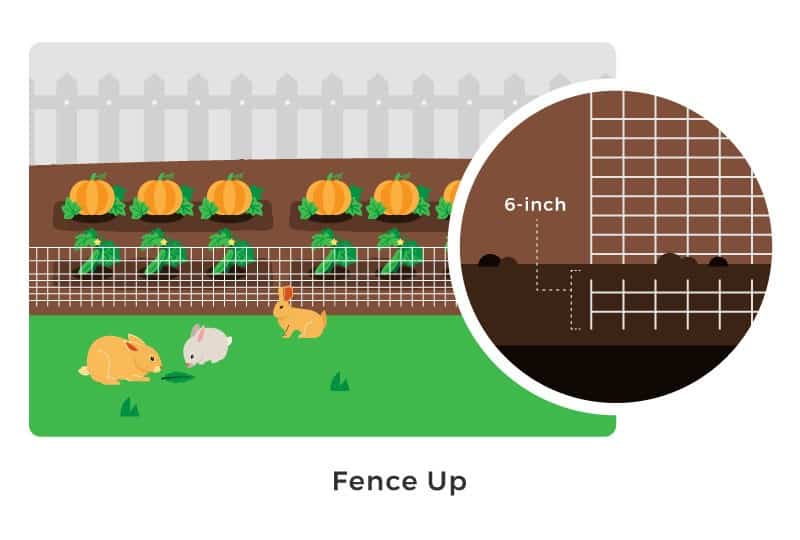
2. Make your yard less appealing
Bunnies are preying creatures; therefore, they stay around in the most convenient places and wait for the opportune time to strike. Even though the idea of doing away with their habitats is often over-looked, it works.
You can do away with, alter or bar the habitat area of the rabbits. You can also choose to eliminate the bushes, shrubs, thick vegetation, and dirt pile in your farm to deny them habituating alternatives. The animals only feed where they can get cover from enemies, and the collections give them such an environment.
Apart from that, you can decide not to grow attractive foods along the fences and save that for the middle part of the farm.
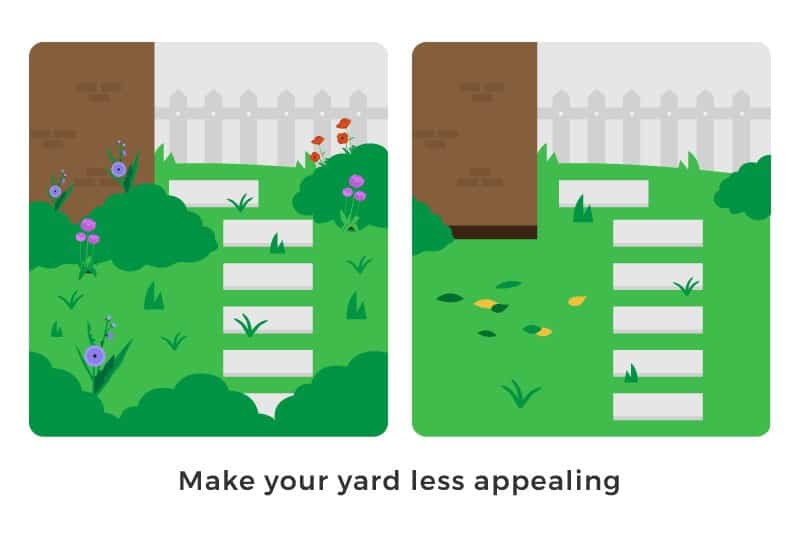
3. Redirect rabbits from your garden
Use veggies that you won’t mind losing or the rotten produce for diversion. You can take the cabbages and carrots and place them somewhere in your yard, away from your crops. The animals will go for them and leave the fresh plants in the yard alone.
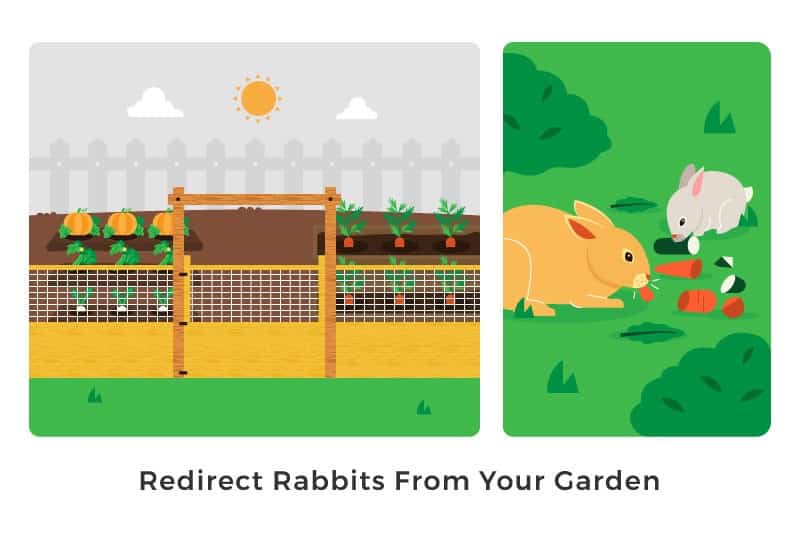
4. Use scare tactics
Make their enemies, your friend. Keep pets in your yard. Cats and dogs love running after and chasing rabbits, moles, squirrels. You’ll be making the pets resourceful and also giving them free entertainment.
Another brilliant way is to use dog fur and spray it on the farm. The smell of a dog nearby will frighten them off, and good for you, it costs nothing.
Apart from that, flashlights, fake snakes, and owls are a threat to the coneys. You can curate mimics of the creatures and place them in the yard. Relocate them in different positions on the farm to keep the animals on toes. They may convince the little monsters that your land isn’t safe to hunt.

5. Use rabbit repellants
You can sprinkle chemical repellents onto the crops that are prone to destruction by the coneys. These sticky repellants have an annoying odor and flavor to the animals.
Strong smells scare the rodents because somehow, they indicate an oncoming enemy, so they will choose to stay far from the predators.
However, the fluffy animals may accustom to the smell over time and fear it no more. It is therefore wise to alternate the repellants to make them more useful. Also, seek for more reliable repellants since some are not durable, and you may have to reapply after some time.
Besides that, the solution can be toxic to humans if they consume vegetation. Ensure that you read the instructions and understand before using this option.
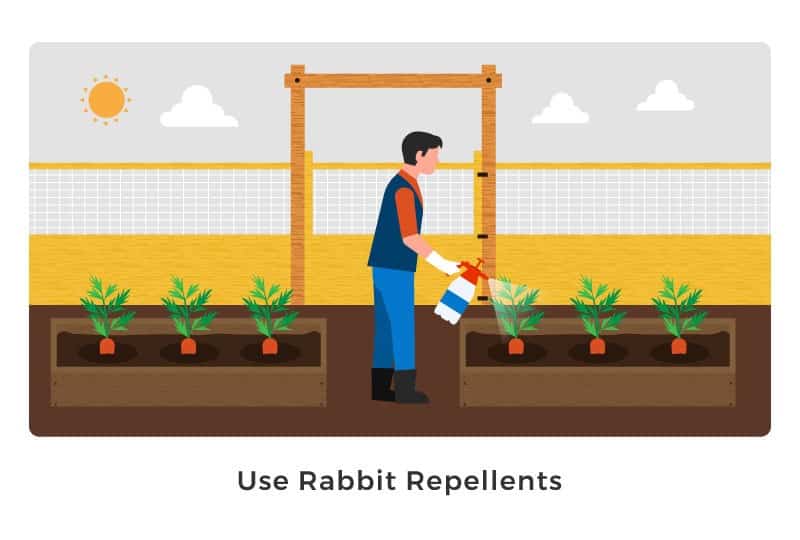
6. Locate and trap
Setting traps isn’t practical if you do it by yourself. It requires the help of specialists since handling them in traps requires strategies.
You have to ensure you don’t harm them in the process. Check with the local services for help, since they also carry diseases.
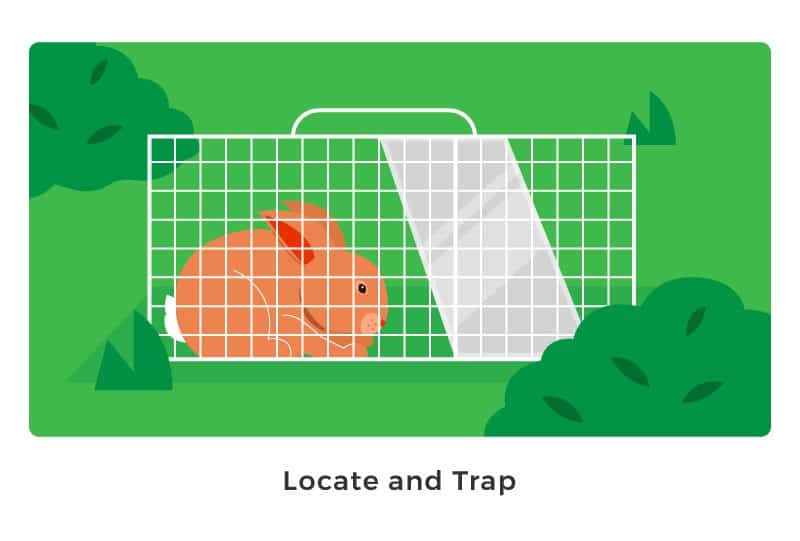
7. Protect individual plants
Use mesh wire netting to build cylindrical cages around the tender and young trees, shrubs, and vines for protection until they grow. When they grow, their barks will be tough and hard, unfit for the animals.
Although it is helpful, ensure that the barrier is rooted in the ground to ensure that the rodents do not burrow their way to the crop.
The cylindrical cages should be 2-4 inches wider than the crop’s circumference to bar the rodents from pushing the wire for the plant.
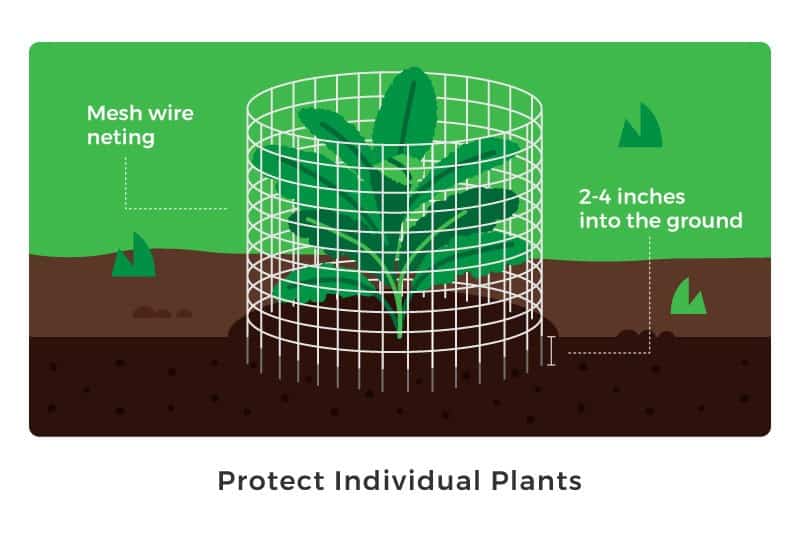
8. Grow rabbit resistant crops
Let your frustration not convince you that there are no veggies that the coneys don’t eat. You can take a break from your inviting vegetables and choose crops that will not attract rabbits. These are plants with robust smells, prickly branches, or creamy saps.
Crops such as berries, currants, pricky cane fruits, onions, garlic tomatoes are not victims to the stuffy fluffy creatures.

9. Population control
Your fruity, juicy veggies create captivating breeding environs for the bunnies. They multiply enormously even when they lack food. Each offspring can reproduce forth a dozen or more little coneys, and the mother can fall pregnant soon after.
First, identify the rabbit and check with animal protection services in your area. They may have means of catching and shifting the animals to the wild.

10. Encourage predators
The place of the coneys on the food web makes them have a long trail of predators. The use of predators is to the farmer’s advantage. Raccoons, foxes, hawks, and eagles attack and eat the rabbits.

Summary
Rabbits are tiresome to deal with, and they never go away completely. They can be cruel enough to wipe off the crops in your land overnight. Do not allow your hard work to end up in the belly of undeserving creatures.
With a little work, you can keep these cheeky creatures out of your green haven and enjoy your labor. The ideal way to deal with this threat is to curate reliable means to protect your plants and hope the rabbits are no smarter than that.





